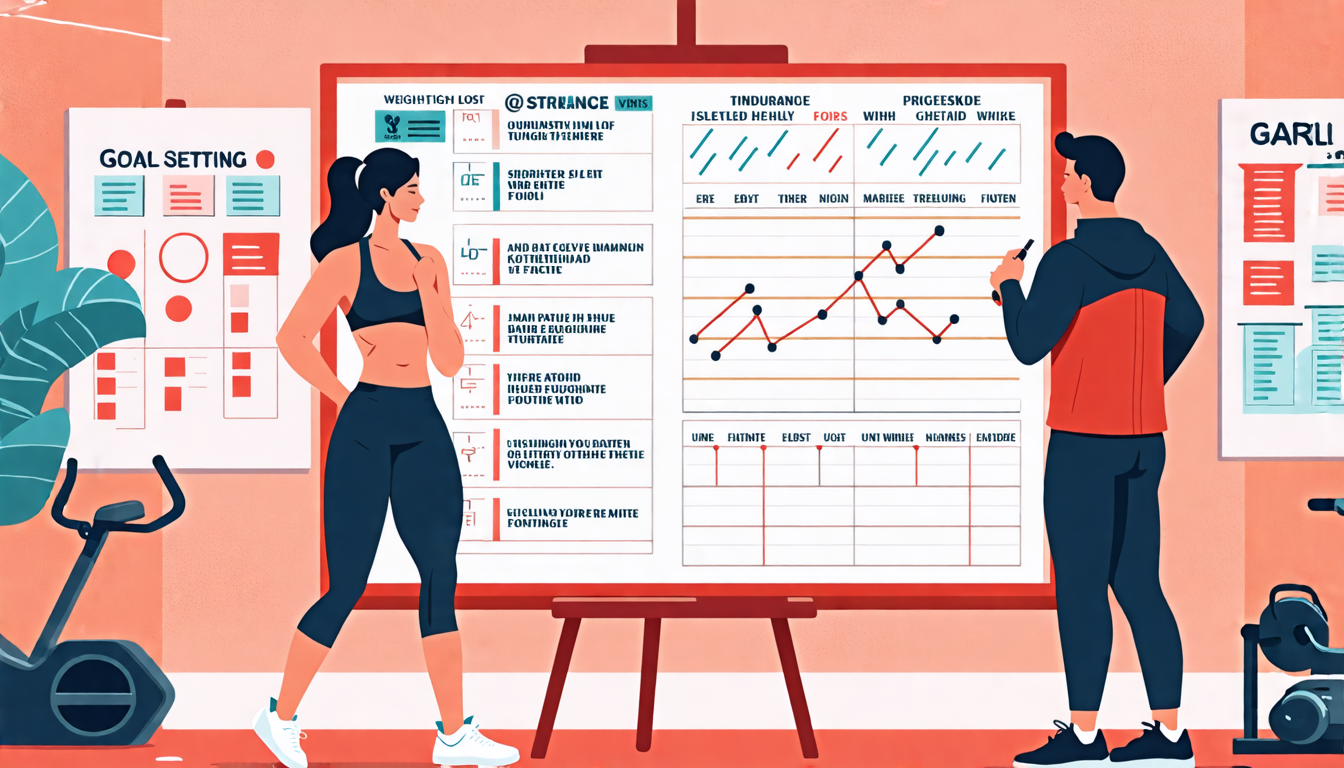Setting clear fitness goals is one of the foundational steps to a successful fitness journey. By understanding the importance of setting tailored fitness objectives, you can enhance your motivation, track your progress more effectively, and achieve better results. Whether you’re aiming to shed those extra pounds, build muscle, or improve your overall health, having well-defined goals not only gives you direction but also keeps you focused and committed to your workout regimen. In this article, you’ll learn how to assess your fitness goals using the SMART criteria—Specific, Measurable, Achievable, Relevant, Time-bound—ensuring your objectives are realistic and attainable. Additionally, we’ll explore the importance of regular evaluation and adjustment, allowing you to track your progress and adapt your goals based on performance and feedback. By following these strategies, you can create a dynamic fitness plan that evolves with you, helping you stay on track and reach your desired outcomes efficiently.
Understanding the Importance of Setting Fitness Goals
Why You Should Set Fitness Goals
Setting fitness goals plays a pivotal role in achieving a healthier, stronger body. These goals serve as a roadmap, guiding you through your fitness journey by defining clear, actionable tasks. Without well-defined objectives, you’re more likely to lose sight of what you’re striving for, making it easier to become complacent and abandon your fitness routine altogether.
One of the primary reasons for setting fitness goals is that they provide a sense of direction. Whether your aim is to lose weight, gain muscle, improve endurance, or enhance overall health, having specific targets allows you to develop a structured plan. This structure ensures that every workout session, dietary choice, and lifestyle change is aligned with your desired outcome.
Moreover, setting fitness goals helps in breaking down daunting tasks into more manageable portions. Instead of vaguely aiming to get fit, you could specify goals such as lose 10 pounds in two months or run a 5K marathon in six months. These concrete objectives are less overwhelming and give you a clear path to follow, boosting your confidence and commitment to achieving them.
Key Benefits of Having Clear Fitness Objectives
Enhanced Motivation
One of the most significant benefits of having clear fitness objectives is enhanced motivation. Motivation often wanes during a fitness journey, especially when results are slow to appear. However, when you set specific goals, you create a tangible end point to aim for. This focal point can reinvigorate your enthusiasm and dedication, making it easier to get through challenging workouts and stick to your nutrition plan.
For instance, let’s say your goal is to improve your cardiovascular health within three months. Each time you feel like skipping a workout, recalling this objective can reignite your sense of purpose. The thought of achieving better heart health and conditioning can serve as a powerful motivator, reminding you why you started in the first place.
Furthermore, fitness goals can act as milestones that reward you along the way. Each small victory, whether it’s losing a certain number of pounds or lifting heavier weights, serves as a motivational boost that propels you forward. These incremental successes make the larger goal seem more attainable and keep the momentum going.
Better Tracking and Progress Measurement
Having well-defined fitness goals also facilitates better tracking and progress measurement. Without goals, evaluating your fitness journey can become ambiguous and unsatisfying. Clear objectives provide specific criteria against which you can measure your advancements, making it easier to see how far you’ve come and what still needs improvement.
For example, if your goal is to bench press a certain weight within three months, you can track your lifting records each week. This kind of detailed tracking allows you to see consistent progress, even on days when you might feel you’re stagnating. It also helps in identifying patterns, such as plateaus or sudden improvements, which can inform necessary adjustments to your routine.
Moreover, progress measurement is essential for accountability. Documenting your achievements and setbacks can serve as a reality check, helping you stay honest about your efforts. This accountability ensures that you’re continuously making strides towards your ultimate fitness goals, rather than just going through the motions.
In addition, tracking your progress can have significant psychological benefits. Seeing tangible evidence of your hard work, such as before-and-after photos, improved performance metrics, or increased stamina, can boost your self-esteem and reinforce the positive changes you’re making. This visual and numerical evidence of progress is immensely satisfying and can help sustain long-term commitment to your fitness regime.

How to Assess and Adjust Your Fitness Goals Effectively
SMART Criteria for Goal Setting
One effective method to assess and define your fitness goals is by using the SMART criteria. The SMART framework helps in creating goals that are clear, precise, and attainable, which can significantly boost the chances of achieving them. Let’s break down each element of the SMART acronym:
Specific
To achieve your fitness objectives, ensuring that your goals are Specific is crucial. Vague goals like I want to get fit or I want to lose weight lack direction and can lead to frustration. Instead, be clear and precise about what you want to achieve. For example, I want to lose 10 pounds of body fat in the next three months or I want to run a 5k race in under 25 minutes. This specificity gives you a clear target to aim for and helps streamline your efforts, making your goals more attainable.
Measurable
To know whether you’re making progress, your goals should be Measurable. Quantifiable goals enable you to track your progress objectively. Use metrics that are easily monitored, such as weight, body measurements, running time, or the number of repetitions of an exercise. With measurable goals, you can assess if your fitness regimen is working or if adjustments are necessary. For example, tracking your running pace using a stopwatch or app allows for precise measurements and easier adjustments.
Achievable
Setting goals that are Achievable ensures that you’re not setting yourself up for failure. While it’s important to challenge yourself, it’s equally critical to be realistic. Assess your current fitness level and lifestyle when setting your objectives. For instance, if you’re a beginner, aiming to run a marathon within a month might be overly ambitious. Instead, choose goals like jogging a mile without stopping or completing a beginner’s 5k program. Achievable goals help keep your morale high and foster a more positive experience on your fitness journey.
Relevant
Your fitness goals should be Relevant to your overall health and wellness aspirations. If your primary aim is to improve cardiovascular health, setting a goal to bench press a heavy weight might not align with your main objective. Ensure that your goals are pertinent to what you genuinely want to achieve. For example, if your objective is to enhance endurance, setting a target to run longer distances within a specific timeframe would be more relevant than focusing solely on strength training.
Time-bound
Establishing goals that are Time-bound adds a sense of urgency and keeps you focused. Set a specific timeframe in which you plan to achieve each goal. Whether it’s aspiring to lose five pounds in a month or enhancing your squat strength by 10% over a six-week period, a deadline keeps the momentum going. This time-bound aspect serves as a motivating factor and helps in prioritizing your fitness activities.
Regular Evaluation and Adjustment
Once you’ve set your SMART fitness goals, the next crucial step is regular evaluation and adjustment. Fitness is a dynamic aspect of life, and your goals should adapt to changes in your progress and circumstances.
Tracking Progress
Consistently Tracking Progress is essential to understand how far you’ve come and what adjustments are necessary. Documenting your activity helps in identifying trends, overcoming plateaus, and staying motivated. Use tools like fitness apps, journals, or even simple spreadsheets to log your workouts, diet, and any changes in body metrics. Visual representation of your progress can be incredibly motivating. For example, seeing your running times improve or witnessing a gradual decline in your body fat percentage can serve as powerful reinforcement that you’re on track.
Adapting Goals Based on Performance and Feedback
As you track your progress, it’s equally important to Adapt Goals Based on Performance and Feedback. Fitness isn’t a linear journey. You may encounter setbacks due to injuries, illnesses, or life changes. Be flexible and adjust your objectives as needed. If you find that a goal is too challenging or too easy, don’t hesitate to modify it. Performance feedback, whether from a trainer, a fitness app, or personal observations, can offer valuable insights into how and why you should pivot. For example, if you consistently find you’re unable to meet your running time goals, it may indicate the need for a revised strategy, such as improved nutritional plans or incorporating more rest days.
Regular assessments and adjustments of your fitness goals not only keep you on the right path but also make your fitness journey more enjoyable. Adaptability ensures that your goals remain relevant to your current situation and capabilities, leading to sustained progress and long-term success.
In conclusion, setting and assessing your fitness goals is a fundamental process that can significantly enhance your overall success in achieving desired health outcomes. Establishing clear fitness goals provides a strong foundation for motivation, as it gives you a target to strive towards and a benchmark for measuring progress. The benefits of having well-defined objectives extend beyond mere inspiration; they allow for effective tracking and progress measurement, ensuring that you stay on course and make informed adjustments as needed.
Utilizing the SMART criteria—Specific, Measurable, Achievable, Relevant, and Time-bound—is essential for creating goals that are not only attainable but also tailored to your individual needs and circumstances. Applying this structured approach ensures that your objectives are clear and realistic, increasing the likelihood of sustained progress. Additionally, the practice of regularly evaluating and adjusting your goals is crucial. By consistently tracking your progress and adapting your targets based on performance and feedback, you maintain a dynamic and responsive fitness plan that can evolve with you.
Ultimately, the process of assessing and refining your fitness goals is an ongoing journey. It requires dedication, self-awareness, and a willingness to adapt as you grow and develop. By embracing these practices, you set yourself up for continuous improvement, ensuring that your fitness endeavors remain effective and rewarding over the long term.

